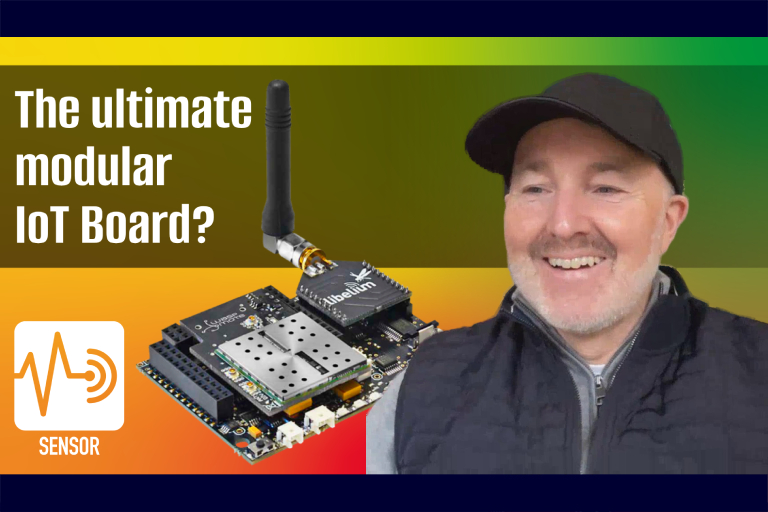Libelium’s Waspmote is a modular development platform that allows designers to quickly assemble a low-power IoT system for a wide variety of applications. The system comprises a 73.5 x 51 x 13 mm microcontroller board, based on the ATmega1281, and the user’s choice of 7+ sensor boards spanning 120+ sensors, wireless boards for 15 radio technologies, and several boards for physical connection using industrial protocols.
As well as boasting the industry’s lowest power consumption for a full IoT platform – just 7 µA in hibernate mode – the key advantage of Libelium’s solution is that all software/firmware integration is done for you, significantly cutting development time. The large range of sensors and connectivity options from leading third-party vendors also promotes reliable operation and familiarity with the components.
Waspmote also features Over The Air (OTA) programming capabilities for firmware upgrades or changes across an entire IoT network in minutes, without physical access; this is done via FTP to prolong battery life. Waspmote can be programmed using Libelium’s open-source SDK and API, and several encryption libraries are provided to secure your IoT against external threats.
The MCU base board and user-defined sensor and connectivity options are summarised below. Full documentation for this extensive development platform can be found on the Waspmote development Wiki, which provides access to datasheets for each board.
MCU Base Board
The Waspmote base board serves as the heart of the platform and has been designed to minimise power consumption for your IoT device by using digital switches to only direct power to the sensor and radio modules when required. Waspmote features four power modes with the following current consumption:
-> On: 17 mA
-> Deep Sleep: 33 µA
-> Hibernate: 7 µA
The Waspmote platform is controlled by an ATmega1281 MCU with a clock frequency of 14.74 MHz. This is supported by 8 kB SRAM, 4 kB EEPROM, and 128 kB flash memories. An additional SD card (up to 16 GB) can be used for other memory requirements, including firmware. This board features an accelerometer, an RTC at 32 kHz, 7x analogue inputs, 8x digital I/Os, and 2x UART, 1x I2C, 1x SPI, and 1x USB peripheral interfaces.
Waspmote can be powered using a 3.3-4.2 V battery with charging via 5 V USB at 100 mA, or a 6-12 V solar panel load at 300 mA. The weight of the base unit alone is 20 g, and it is suitable for continuous operation in environments from -20°C to +60°C – short-term operation is supported for a further 10°C either side of this operating range.
Sensor Board Options
Waspmote’s sensor boards provide access to more than 120 sensors with all the interfacing work done in advance to ease development. These sensors are clustered into several application-focussed boards, which are summarised below. Custom boards can also be created.
“Gases PRO” senses more than 10 different gases, particulate matter and dust, temperature, humidity, and pressure to support applications that include city pollution monitoring, air quality index calculation, emissions monitoring from farms and hatcheries, greenhouse management, control of chemical and industrial processes, and forest fire prevention/defence.
“Events” includes physical sensors for vibration, impulse, tilt, hall effect, liquid presence and flow, luminosity, and object detection. This board also features a relay to control external DC units for security, emergency, logistics, and actuation applications.
“Smart Agriculture” senses environmental conditions, soil properties, plant measurement/growth, solar radiation, UV, wind, luminosity, and more for applications that include precision agriculture, irrigation systems, greenhouses, and weather stations.
“Smart Water” features sensors for pH, oxidation-reduction potential, dissolved oxygen, conductivity, temperature, and more for applications such as potable water monitoring, chemical/pollution leakage detection in the sea and rivers, and swimming pool water quality monitoring.
“Smart Water Ions” focusses on dissolved chemical detection with sensors for temperature, pH, and 15 different ions for applications that include drinking water quality control, agriculture water monitoring, swimming pool monitoring, and waste water treatment.
“Smart Cities PRO” combines sensors for noise level, 9+ gases, particulate matter, distance, luminosity, temperature, pressure, and humidity for use in applications such as noise maps, air quality monitoring, and waste management.
“Smart Parking” is an extremely application-specific module that uses magnetic and radar sensors in conjunction with built-in LoRaWAN for vehicle detection and parking lot control.
The “4-20 mA” board allows designers to choose their own sensor for monitoring processes in industrial scenarios, with a range of up to 900 m.
Connectivity Board Options
Waspmote supports 15 wireless technologies, which can be used as a single technology or paired using the “Expansion Radio Board”. These technologies include long-range, medium-range, and short-range options as detailed below:
-> Long range – 4G / NB-IoT / Cat-M / LoRaWAN / LoRa / Sigfox / 868 MHz / 900 MHz
-> Medium range – ZigBee / 802.15.4 / DigiMesh / WiFi
-> Short range – RFID-NFC / Bluetooth 2.1 / Bluetooth Low Energy
Additional boards for RS-485, Modbus, CAN Bus, and 4-20 mA industrial protocols allow designers to connect Waspmote’s sensors to industrial environments.
If you’d like to evaluate Waspmote for use in a commercial project, fill out the form below, and ipXchange will put you in touch to discuss your configuration and the full range of options available. Alternatively, Libelium also offers preconfigured, encapsulated versions of Waspmote with full certification for immediate deployment.






